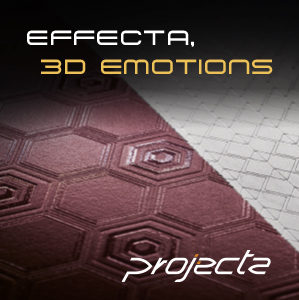Esmalglass-Itaca brings "digital material" into the ceramic
High technology for a production process completely digital
Each day is more obvious the absolute revolution of digital technology in the world of ceramics, a revolution that started with the pigmented inks and that has proved to the producers of pavements and ceramics the great advantages that brings, productive and economical.
But, why only look at the advantages in digital decoration, when ceramic is much more than that? The ceramic is the addition of textures, contrasts, brightness and different contacts that are achieved by adding material. And if you get to add this material with digital systems that will allow you to decorate and glaze simultaneously and in a synchronized manner, you will be multiplying the numerous advantages of the digital technology. That's why Esmalglass - Itaca has as an objective to deposit material digitally. This has been the beginning of the development of the family of products DPM, Digital Printing Materials.
The DPM material series is designed for its application through digital systems bringing material to the ceramic and creating a completely digital process that goes from the press exit to the oven entrance. It is divided in two subfamilies depending on the particle size: DPM submicron and DPM micron.
The DPM submicron material is adapted to the actual printing heads. This material contains nanometric particles whose particle size distribution gives an excellent physical stability in addition to optimum performance in these headers. The amount of material deposited is less than the 100 gr/m2, with normal quantities similar to the current injection inks.
Within this category we can find materials that complement the current decor and create special effects. We can find: a white used to decorate or as a base for digital inks; a transparent shine effect designed to create areas of mate-gloss contrast; a reactive "camaleonte" that creates small variation of level in the base glaze making micro relieves.
The DPM Micronic materials are adapted to the new printing heads of high discharge that allow weights of material superior to 100grs/m2, exceeding the km/m2. These materials are characterized by an aqueous base and a particle size greater than 3 micron. This greater particle size compared to submicron materials is directly linked to two concepts: the price and the ceramic effect that is achieved. On the one hand, it presents a major decline in the price with respect to the materials sub-Micronics, something indispensable for the realization of his industrial use with high weights. And, in the other hand, we get to deposit digitally quantities of material that are equal to the weight deposited at the moment by bells, flat screen printing, and rolls or fumés. These two facts reinforce the idea of creating a totally digital process of ceramic production.
In this category of DPM Micronic we have: shinny white, mate white, transparent mate, transparent mate satin and a crystalline. Can be applied in thick layers of material to full field, before or after the decoration, or as a design define and synchronized with the rest of the process to create thickening effects as in screen printing or with rollers; and even to create relieves that, at the moment, can only be done with a press mold. You can get any kind of coating comparable to the existing methods but with all the productivity advantages that brings the digital technology.
It should be noted that Esmalglass-Itaca has been studying for several years to develop this type of materials, which were made public for the first time with the Gold Alfa, won in 2011, and therefore has patented the micronic digital enamels of high discharge.
Both types of materials, Micronics and sub-Micronics, are developed for its application to any type of manufacturing: porous, stoneware, double-firing, etc. Have also been optimized all the compositions to enhance the aesthetic and technical specifications required by the current ceramic, while ensuring the highest chromatic development of the inkjet Esmalglass-Itaca pigmented inks in their joint use.
The advantages of a fully digital process along with the materials Esmalglass-Itaca DPM are countless and cover both improvements in the product as improvements in the productive process and the management that lead to costs. From an aesthetic point of view we can get new finishes and structures, or make new developments in a much more agile way. From a production point of view and management will be able to reduce the length of the line of manufacturing, reducing development times for new products, reduce or eliminate the expendable supplies and typical of the traditional decorations, we will have greater flexibility and speed in the change of modelling and reduce the tones produced with the consequent simplification of warehouses.
Finally, the family Esmalglass-Itaca DPM goes beyond the simple digital decoration with digital colour and decorates with "material", contributing to the producer and ceramic designer with a huge range of new possibilities to create a product that is clearly differentiated and produced through a fully digital process.
Did you find this article useful?
Join the CWW community to receive the most important news from the global ceramic industry every two weeks





















